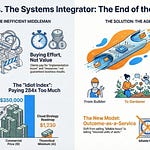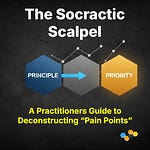Introduction: The Red Ocean of AI
The current race in the Large Language Model (LLM) space feels like a frantic sprint, but it's actually a marathon being run with a flawed map. From the outside, the competition is dazzling. Multi-billion dollar valuations, models that can generate poetry and code in the blink of an eye, and a relentless news cycle heralding the dawn of a new technological era. It seems unstoppable.
But beneath the surface, a dangerous pattern is emerging. Most frontier LLM companies are locked in a brutal battle of "Product Performance." Who has the most parameters? The fastest inference time? The highest benchmark score on the latest academic test? While impressive, this is a race to the bottom. It's the commoditization trap in action.
The core problem is this: frontier LLM companies are stuck in a product performance innovation trap, selling access (APIs) and raw intelligence instead of solving higher-order business problems. When everyone is selling the same basic commodity—in this case, intelligence-as-a-service—the only long-term competitive lever is price. That is a red ocean of competition, where the fight for market share turns bloody and profits evaporate.
But there's a way out. The path to sustainable, defensible profitability lies not in building a marginally better model, but in architecting a profoundly better business model. This requires a fundamental shift in perspective, moving from a technology-first mindset to a customer-problem-first one. By using powerful frameworks like Jobs-to-be-Done (JTBD) and expanding our view of what "innovation" truly means, we can design a new financial blueprint for the AI era. It's time to move beyond the API and build something that lasts.
Deconstructing the Challenge with First Principles
To escape the conventional thinking that has led to this commoditization trap, we need to go back to basics. First principles thinking, a method championed by thinkers from Aristotle to Elon Musk, forces us to break down a problem into its most fundamental truths, independent of analogy or convention1. Let's apply it here.
1. What is the fundamental goal?
The ultimate goal of any commercial enterprise, including a frontier LLM company, is to create sustainable, long-term financial success. It is not simply to build the most advanced technology; it is to build a durable business that generates profit.
2. What are the current, flawed assumptions?
Reasoning by analogy, most companies have adopted a set of assumptions based on previous technology waves (e.g., cloud computing):
"We must have the biggest, fastest, and most capable model to win."
"Success is measured by benchmark performance and technical superiority."
"The business model is to sell access to our superior model via an API, just like AWS sells access to compute."
"More features and capabilities in the model will automatically lead to more customers."
3. What are the fundamental principles we can rebuild from?
Let’s break this down to its bare-bones truths:
Customers do not buy products or services; they "hire" them to make progress in their lives or get a "job" done. A construction company doesn't want a quarter-inch drill; it wants a quarter-inch hole.
Value is created by helping a customer get their job done better (faster, more predictably, with higher quality) and/or more cheaply.
A company's product or technology is merely the current solution customers are hiring. The underlying job is stable over time, while the solutions evolve dramatically.
Sustainable profit comes from creating differentiated value that is difficult for competitors to copy.
From this new foundation, the conclusion is clear: the LLM itself is not the product. It is a component. It is an incredibly powerful, general-purpose component, but it is a component nonetheless. The current strategy of selling API access is akin to an engine manufacturer trying to sell engines directly to commuters. While some hobbyists might buy one, most people just want to buy a car. The real business opportunity isn't in selling the component; it's in building the integrated solution that gets the whole job done.
Finding the Real Job: What Are Customers Hiring an LLM For?
Jobs-to-be-Done (JTBD) theory provides the lens we need to see beyond our own products and into the true motivations of our customers7. It forces us to understand the "why" behind their actions. A business isn't "hiring" an LLM to "generate text." That's a task. They are hiring it to achieve a much higher-level objective.
Consider the hierarchy of jobs:
Functional Jobs: These are the practical, objective tasks the customer is trying to accomplish. Instead of "generating text," the real functional jobs are things like:
Accelerating new drug discovery for a pharmaceutical company.
Reducing customer acquisition costs for a marketing team.
Automating regulatory compliance checks for a financial institution.
Increasing the predictive accuracy of financial forecasts for an investment firm.
Developing personalized learning paths for students in an education tech company.
These jobs are stable. A century ago, marketing teams were still trying to reduce customer acquisition costs, they just used very different tools. The job is the anchor, while the technology is the variable.
Emotional & Social Jobs: Beyond the functional aspects, there are powerful emotional and social drivers. These jobs are about how customers want to feel and be perceived by others.
Feeling confident in a high-stakes market forecast.
Reducing the anxiety of a potential security breach.
Being perceived as an industry innovator by peers and competitors.
Feeling assured that the company is operating ethically and in compliance.
Focusing on the job, not the technology, is the only way to build a long-term strategy. While your LLM's architecture may be obsolete in 18 months, the core job of "reducing customer acquisition cost" will still be there. The company that orients itself around solving that job, using the best technology available, is the one that will endure.
A New Blueprint: Applying the 10 Types of Innovation
If the LLM is just one component, how do you build the rest of the machine? This is where Doblin's 10 Types of Innovation framework becomes an essential tool. It acts as a "periodic table for innovation," revealing that breakthrough success rarely comes from product innovation alone. Lasting competitive advantage is built by innovating across multiple dimensions simultaneously. The framework is organized into three categories: Configuration, Offering, and Experience.
Let's use this playbook to design a new business model for a frontier LLM company, moving far beyond the simple API.
Configuration Innovations (The Engine Room)
These innovations are focused on the internal workings of your business. They are often invisible to the end customer but are incredibly powerful and difficult for competitors to copy.
Profit Model: From Pay-Per-Token to Pay-for-Value
The current model of charging per token (or per character) is a direct analogy to selling compute power. It's a cost-based model that immediately puts you in a price war. A JTBD approach reveals a much more powerful alternative: value-based pricing. If your solution helps a customer get their job done better, you should share in the value created.
Old Model: You pay us $0.01 per 1,000 tokens to analyze this financial report.
New Model: Our platform analyzes your entire portfolio and identifies compliance risks. We charge you 1% of the fines you avoid, or a flat fee per report that is a fraction of what you pay your legal team.
This aligns your financial success directly with the customer's success. You are no longer a cost center to them; you are a profit driver. This could also involve subscriptions, licensing, or performance-based contracts.
Network: From Lone Wolf to Ecosystem Orchestrator
No single company can solve a complex customer job entirely on its own. Network innovation is about creating value by partnering with others. An LLM becomes exponentially more valuable when it's connected to other resources.
Old Model: Here's our API. Good luck finding the data you need to make it useful.
New Model: We have built a financial services ecosystem. Our LLM is the hub, and we have pre-built, secure integrations with leading proprietary market data providers, regulatory bodies, and a network of certified financial consultants who can help you implement and validate the results. We create a one-stop solution for the job.
This creates a powerful moat. A competitor can't just copy your model; they have to replicate your entire network of partnerships and integrations15.
Structure: From Tech Silos to Job-Centric Teams
Structure innovation is about how you organize your talent and assets. Most tech companies are structured around their technology stack: the data ingestion team, the model training team, the inference optimization team. This internal focus can blind you to the customer's real needs.
Old Model: Engineering teams are organized by technical function.
New Model: We organize our teams around the customer jobs we solve. We have a "Drug Discovery" team composed of machine learning engineers, computational biologists, and product managers who are all dedicated to solving problems for pharmaceutical R&D. We have a "Customer Support Automation" team with similar cross-functional roles.
This aligns your company's structure with your customer's job, ensuring that every decision is filtered through the lens of what will help the customer make progress.
Offering Innovations (The Core Offering)
This is the category that includes your core product or service. While it's the most visible type of innovation, it's also often the easiest to copy. The key is to think beyond a single feature set.
Product Performance: The Current Arms Race
This is where everyone is focused today: making the core LLM faster, more accurate, and more capable. This is necessary—you need a high-performing engine—but it is not sufficient for long-term success. It's the table stakes, not the winning hand.
Product System: From API to Integrated Platform
This is where you truly elevate the level of abstraction. A Product System is about creating complementary products and services that work together19. Instead of just selling the component, you sell the entire machine, fully assembled and ready to run.
Working Today (Incremental Improvement): A good first step is to bundle your LLM with proprietary datasets and fine-tuning tools for a specific industry. For example, a "Legal LLM" that comes pre-trained on a massive corpus of case law and includes tools for lawyers to fine-tune it on their firm's private documents. This is a better system than a raw API.
Novel Concept (Breakthrough Innovation): The real leap is to create a single, integrated platform that automates an entire business process, making the LLM a critical but invisible component. Imagine a "Go-to-Market Platform" for a new product launch. The user, a product marketing manager, inputs their product details and budget. The platform, powered by an LLM in the background, then:
Performs market and competitor analysis.
Defines target customer segments.
Generates dozens of ad copy and creative variations.
Writes blog posts and social media updates.
Creates and launches the ad campaigns on multiple platforms.
Monitors performance and automatically optimizes the campaigns.
The user no longer needs to hire a marketing team, subscribe to five different software tools, and manually stitch them all together. This novel solution gets the entire job of "launching a marketing campaign" done in a completely new way. It's simpler for the user, delivers a better result, and has far fewer visible "features" because the complexity has been abstracted away.
Experience Innovations (The Customer Interface)
These innovations focus on your customer-facing elements. In a world of similar core technology, the customer's experience can become a powerful differentiator.
Service: From Self-Serve to Guaranteed Success
Service innovation is about supporting and amplifying the value of your offerings. A raw API is the ultimate self-service model, which places the entire burden of success on the customer.
Old Model: Here's our documentation. Here's a user forum. Good luck.
New Model: We offer "JTBD Success Packages." We wrap our core technology with high-value consulting, dedicated implementation engineers, and ongoing support to guarantee that you successfully integrate our platform and achieve your desired business outcome. We don't just sell you the tool; we ensure you succeed with it.
This is particularly crucial for enterprise customers who are hiring a solution for a mission-critical job. The service becomes as valuable as the technology itself.
Customer Engagement: From Transaction to Community
Customer Engagement innovation is about fostering compelling interactions that build deep relationships. This transforms your user base from a collection of individual transactional customers into a loyal, collaborative community.
Old Model: Customers interact with us through support tickets.
New Model: We've built a community of practice for "AI in Financial Compliance." We host exclusive events, share best practices from our most advanced users, and facilitate connections between compliance officers at different firms. Our platform becomes the hub not just for technology, but for expertise.
This creates a powerful network effect that becomes a moat. Leaving your platform means not just losing access to a tool, but losing access to a community of peers and a repository of shared knowledge.
Visualizing the Future: Novel Concepts in Action
Let's make this concrete with a detailed example of a novel concept: The "Automated Compliance Officer" platform.
The Job-to-be-Done: For the Chief Compliance Officer (CCO) at a financial institution, the core job is: "Ensuring the firm continuously meets all regulatory requirements to avoid fines and reputational damage."
How the Job is Done Today (The Old Solution): This is a complex, expensive, and fragmented process involving:
Hiring large teams of lawyers and compliance officers.
Subscribing to multiple, disparate software solutions for transaction monitoring, communication surveillance, and regulatory updates.
Conducting endless manual checks and audits.
Hiring external consultants for periodic reviews.
High levels of stress and anxiety about missing a critical new regulation.
The Novel Solution - The Automated Compliance Officer Platform: This is a single, integrated platform that gets the entire job done.
It continuously ingests and interprets the latest regulations from government bodies around the world using a specialized LLM.
It securely monitors all internal communications (emails, chats) and trading activities in real-time.
It uses its core LLM intelligence to flag potential compliance breaches before they happen.
It automatically generates the required reports for regulators.
The CCO interacts not with an API or a complex set of tools, but with a simple dashboard that shows the firm's real-time compliance status, highlights key risks, and provides clear, actionable recommendations.
This new solution gets the job done completely differently. It's not just an improvement; it's a transformation. It delivers a better outcome (higher accuracy, lower risk) at a significantly lower cost, and with far fewer visible features for the user to manage.
This concept wasn't pulled from thin air. It was systematically designed by applying creativity triggers to the core problem:
Conclusion: From Tech Provider to Problem Solver
The path to sustainable financial success for frontier LLM companies does not run through the valley of benchmarks. That is a red ocean leading to commoditization and ruin. The real opportunity lies in a fundamental identity shift: from being a provider of technology to being a comprehensive solver of customer problems.
This requires embracing a broader vision of innovation. It's not just about the code; it's about your Configuration (how you profit, partner, and organize), your Offering (the complete system you provide), and your Experience (how you serve and engage with your customers). By focusing on the customer's true Job-to-be-Done, you can build a business that is not easily copied. You create a defensible moat built on ecosystem partnerships, value-aligned profit models, and deeply integrated product systems.
The future of this industry won't be defined by the company with the single best model. It will be defined by the company that uses its model as a foundational component to build the most effective, integrated, and indispensable solution for a critical customer job. The LLM will become an invisible, yet essential, part of our world—the winner will be the company that builds the machine, not the one that sells the gears.
What high-level job in your industry is currently being done with a messy, expensive combination of people and tools? What would a single, integrated, LLM-powered solution that gets that entire job done look like? Share your thoughts in the comments below.
Follow me on 𝕏: https://x.com/mikeboysen
If you'd like to see how I apply a higher level of abstraction to the front-end of innovation, please reach out. My availability is limited.
Mike Boysen - www.pjtbd.com
Why fail fast when you can succeed the first time?
My Blog: https://jtbd.one
📆 Book an appointment: https://pjtbd.com/book-mike
Join our community: https://pjtbd.com/join













